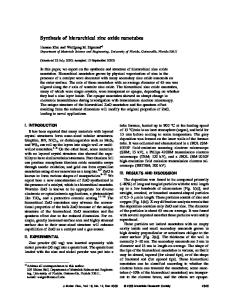Vanadium Oxide Nanotubes: New Synthesis Route and Mechanism of Formation
- PDF / 625,426 Bytes
- 7 Pages / 595 x 842 pts (A4) Page_size
- 50 Downloads / 297 Views
EE9.24.1
Vanadium Oxide Nanotubes: New Synthesis Route and Mechanism of Formation. Maguy Jaber, Nathalie Steunou,* Thierry Azaïs, and Jacques Livage. Chimie de la Matière Condensée (UMR CNRS 7574), Université P. et M. Curie, T54-E5, 4 place jussieu, 75252 Paris cedex 05, France. [email protected] ABSTRACT The synthesis of vanadium oxide nanotubes containing phosphorus (VPOx-NT) is described. A mixture of V2O5.nH2O gels, phosphoric acid and hexadecylamine was heated under hydrothermal conditions at 180°C for 7 days. The VPOx nanotubes were characterized by X-ray diffraction, scanning and transmission electron microscopy, 51V and 31P solid state NMR. In-situ experiments were performed in order to get a better understanding of the mechanism of these nanotubes formation. INTRODUCTION Vanadium oxide based materials have been extensively studied during the past decades due to their electrical, magnetic, catalytic and electrochemical properties. Hybrid organic-inorganic vanadium oxides have been synthesized by the sol-gel process at low temperature or under mild hydrothermal conditions. Depending on the nature of the species present in the reaction medium, they may exhibit a wide range of structures and morphologies that are crucial to the performance of the materials in applications. Recently, mesostructured vanadium oxides with a tubular morphology have been synthesized in the presence of long alkyl chain amines [1]. These vanadium oxide nanotubes are made of multilayer scrolls with thick walls composed of sheet packs of several vanadium oxide layers [1]. The anisotropic tubular shape is expected to lead to unusual physical and chemical properties. The aim of this work is the synthesis of vanadium oxide nanotubes containing phosphate groups (VPOx-NT). The vanadium phosphates phases are currently used as catalysts for the mild oxidation of light alkanes [2]. Therefore, these vanadium oxide compounds could be interesting candidates for catalytic applications since they might combine two advantages: three different contact regions relevant to the tube shape, namely the inner and outer wall surfaces as well as the tube ends, and the presence of phosphorus centres which favours the presence of vanadium in both oxidation state (forth and fifth) and their interconversion. Indeed, the V4+/V5+ ratio of vanadium phosphates phases is known to be critical to the catalytic performance of the materials. In our approach, the synthesis route was based on the procedure already reported [3], that is the reaction between V2O5.nH2O gels and hexadecylamine. For the synthesis of VPOx nanotubes, an amount of phosphoric acid was introduced into this reaction medium. These vanadium oxide nanotubes were characterized by Xray diffraction, SEM, TEM and 51V, 31P NMR MAS spectroscopy. Finally, a discussion on the mechanism of the nanotubes formation based mainly on in-situ experiments is proposed. EXPERIMENTAL DETAILS Phosphorus vanadium oxide nanotubes were prepared from a gel of V2O5.nH2O and hexadecylamine [3]. The molar composition of the s
Data Loading...









